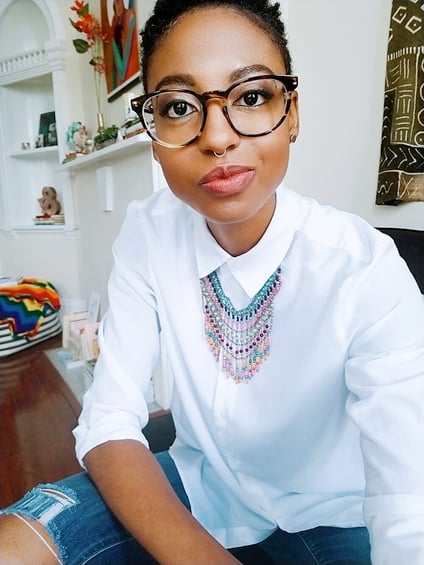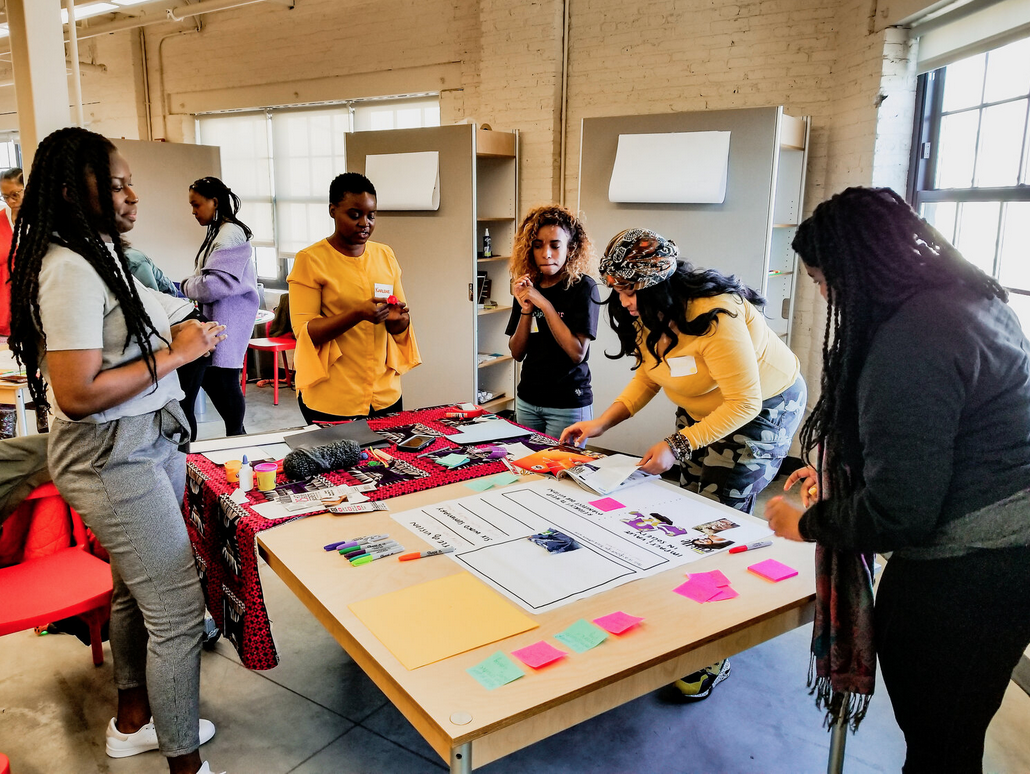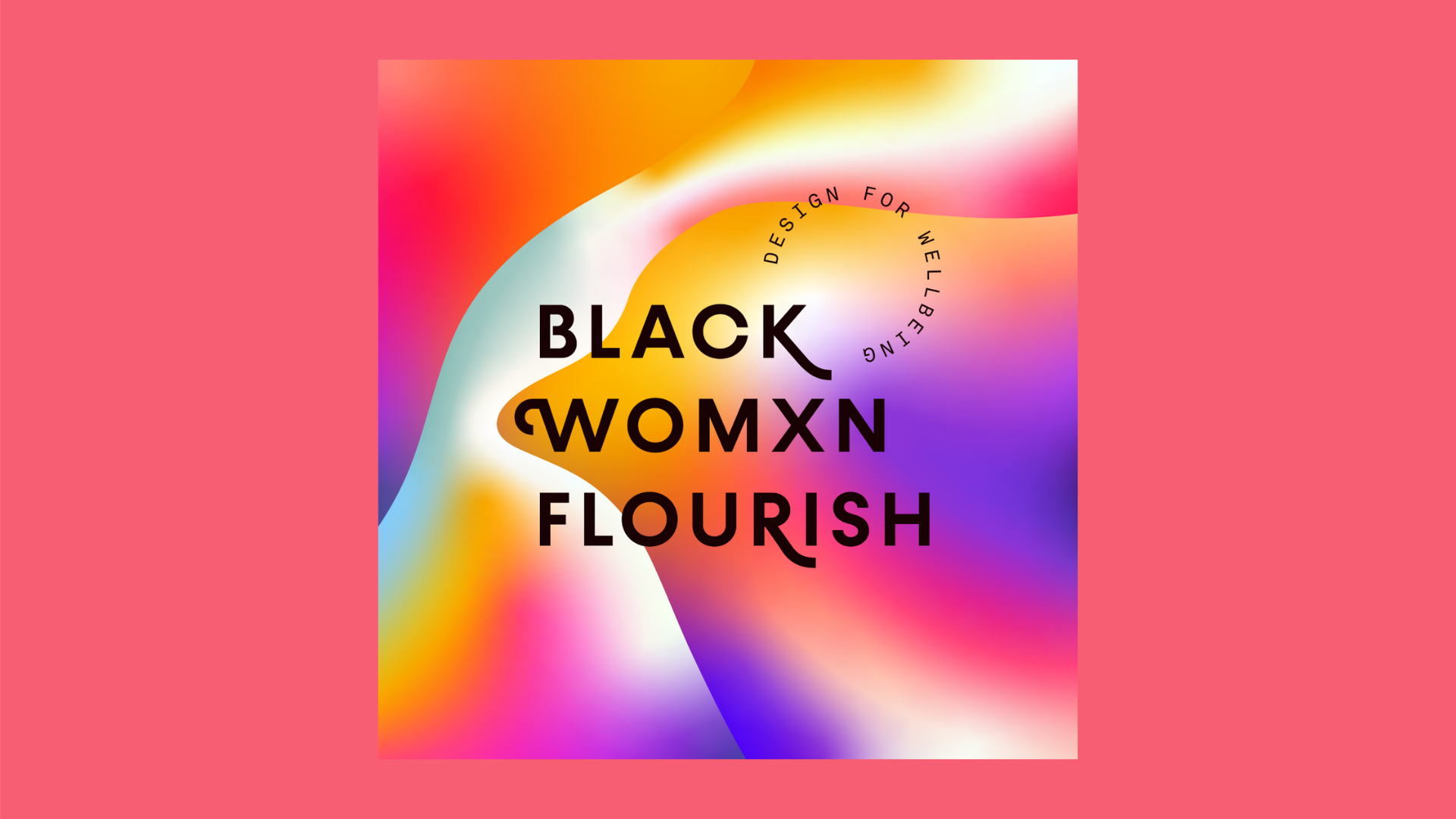Black Womxn Flourish: Centering Black Women's Well-being by Design
Denise Shanté Brown didn’t always know that her life’s work would be at the intersection of well-being and design. Through her thesis work in Social Design for her Master’s degree at the Maryland Institute College of Art, she saw not only the ways that Black women are excluded from decisions about their own health and well-being, but that Black women were able to create their own structures of healing and community. The research process became a healing process for her, as well as a way to explore manifestations of both systemic inequality and resilience in its face.
She founded Black Womxn Flourish, a “design for wellbeing collective shaping the future of Black womxn’s health and healing through creative, community-led practices.” The collective’s central values are celebrating lived experience and abundance, transforming design and health cultures, and trusting Black womxn.
Through workshops, community building, and partnership with other organizations or groups, Black Womxn Flourish creates space and opportunities for Black womxn to work together to determine what they need in order to experience well-being in their lives and in their work, and to envision a joyous and abundant future for themselves.
Denise Shanté Brown shares a look at what design means in the context of her work, how she matches her collective’s mission and values to its own internal workings, how she has cultivated a sense of space and connection even in a virtual context, and how Fractured Atlas fiscal sponsorship has helped her receive funding and become a more savvy business owner.

When you say design, what does that mean?
I'm seeing it as the shared,creative process of bringing experiences into existence. And so it's broad–it's not only tools, strategies, and methodologies. We can also bring forward a point of connection that wasn't there before. We can also bring forward a conversation that needs to be had and recognize that even the design of how we're in relationship to people and ourselves is a part of that shared creative process.
What's the relationship between design and well-being? How does one impact the other? And where does Black Womxn Flourish intervene or build in that interaction?
The relationship between design and well-being isn't something that's seen often. It's starting to pick up in public health spaces. But it's been a new intersection for me and the work, specifically with centering Black women in that process. Design has been an opportunity to facilitate opportunities for healing. We’re using design to facilitate ways that we can think about what tools [and] strategies are available to us or that we can create if they aren't available to shape what's best for our care.
We're creating those spaces and gatherings where well-being and joy can be a possibility, where we're introducing different design methodologies or processes that I have personally learned and made more relevant to Black women, from my own background in social design.
And really getting out of the “human-centered design” framework that does not come with the lens of marginalized folks or center marginalized people and communities. How can we make sure that we're using design in a way that is actually centering people who are normally marginalized in those processes within organizations, within those institutions?
Black Womxn Flourish has a new studio client who we're working with. We're now in partnership with them to center Black women who are leading racial equity and anti-racism work within organizations. So we're trying to think about how we can make sure that the women who are leading the work are actually cared for, that their needs within these organizations and outside of them are viewed as worthy and their work is celebrated.. We're bringing them into the design process to define and determine what it is that they need in order to be well while facing the undue burden of holding a lot of the racial equity work. It may be practices that cultivate more life-giving and liberating environments within the organizations they work within. Or it could be personal practices that they want to use for themselves in order to sustain their minds, bodies and spirits as leaders in the racial justice field.
Co-design, the collaborative, creative approach to shaping change, is at the center of that process. We’re saying, "No, we're not just going to bring the people being impacted into the decision making after we've already decided what the intervention is going to be." How can we make sure that Black women who are impacted by these decisions are part of the conception process from the beginning, from conception to building and ultimately shaping the entire experience? That is very rare and hardly ever happens. It's a newer way of thinking about how we look at that relationship between design and health, specifically when Black women are at the center of it.
So, “design for wellbeing” is our movement and practice at Black Womxn Flourish and our way of thinking about how to creatively look at health and healing, to create pathways toward a more just, pleasurable and flourishing future. We’re offering an invitation, “Let's think about how to approach the way we shape possibilities for care differently.”

Session participants working together
One of the guiding stars that you touched on is about joy and pleasure and ease. How did you arrive at this particular orientation and why it is this central energetic impulse and direction for you?
Well, it didn't start that way! In my thesis, I started looking at depression and anxiety rates, specifically among Black women in Baltimore here. [I] was listening to their stories, their healing journeys, their pain points within the healthcare systems, not feeling heard or respected or cared for in the ways that they needed to by their care providers. They had been starting to find their own creative ways of [healing themselves] outside of the system and looking towards ancestral, spiritual, and nature-based ways of taking care of themselves.
It was a really intense year of focusing on depression and anxiety and also a little personally triggering because it's still personal to me and my own experiences with mental health challenges.
The work being its own salve and healing in and of itself was a way for me to kind of come out on the other side and see that there was such a rich abundance. We have the desire and the interest to care for ourselves. It's not about a lack of self-love. It's about us asking, how can we give attention to our own creativity and all of the nurturance and care and ideas that we've been offering to other people? I decided to stay rooted in the perspective of our boundless brilliance that we have access to instead of the limited views, perspectives and imaginations that come from white supremacy that are creating harm and also leaving us out of the decision making to determine what’s best for us to flourish. We're more than the perceived limitations placed upon us. I just wanted to give my attention to our creative abundance and ingenuity to shift the focus, because it also meant that it was going to be a healthier experience for me. For all of us, really.
I went to Feminist Business School last year with Sister, which is all about approaching the way you build your practice as an entrepreneur with care, ease, slowness. One of the things that has shaped and is continuing to shape the way I approach the work is one of their principles, "A business can be a healing for yourself and others. Everything that you are needing, someone else is needing too. Everything you are healing for yourself, you are healing for someone else too. Make your business a medicine, a salve." I'm in everyday attempts and intention to treat Black Womxn Flourish in that way. I want to make sure that even within our collaborations with other people, groups and movements, we’re tending to our own healing and care as we’re doing the work.
How does that come up for you as you're building this business, this organization community and how you are all moving together?
When we do gather, whether it's in-person or virtually now, we go through this set of rituals that may involve a very deep check-in and not trying to separate our personal from professional, but recognizing that we're wanting to show up as our whole selves.
One day we decided after a meeting and discussing some of our projects that we were going to take our computers or phones outside together and go for a nature walk or just spend some time in the air, you know, feeling where we are in this particular place and moment. That sort of care and attention is what continues to nourish maybe the way we show up in the next meeting, the next conversation that we have with a studio client or a project that we're doing. We want that energy to become integrated into every check-in question, the way we create a flow for a session with a community — all of it coming from a place of intentionality that’s full of care.

Creative resilience session with Baltimore & Beyond Mindfulness Community
How have healing and well-being translated to a virtual world?
With this studio project that I mentioned before [with] the women leading anti-racism work, we did a grounding session that was 90 minutes and you would have thought that we had just spent three hours together. How do you design time with a partner or a collaborator that feels expansive? That feels spacious? Dreaming Flourishing Futures, which is our first virtual, visionary gathering experience. We're bringing Black women together to start the creation of a collective manifesto and making space for us to dream and conjure the futures we’ve been longing for but have yet to experience. We’re also building artifacts from a flourishing future that we see for ourselves and affirming and declaring what will be necessary for us to be well.
We're in the process right now of refining what those two and a half hours look like and how they can center care while we're creating. One of those things involves inviting a collaborator in who's a somatic healer and a bodyworker to invite imagination into the process. We get so quick to jump into ideation mode and start designing solutions right away. But we're saying, “No, let's pause first.” And before we jump into ideation, how can we settle and ground ourselves in our bodies and rest and allow ideas to surface and know that the revolution, the movement, the new world, the new future, whatever you want to call it, won't happen if we're not well-rested and cared for. That's like a huge part of us making sure that healing is a part of the virtual space, too.
There's still energy. There's still energy being exchanged in the virtual space. How can we make the virtual circle a sacred circle? I think it's still possible.
Other than the workshop, what are the other things that are on deck for you?
There's a really amazing group in Baltimore called We Here, and they are Black, Indigenous, people of color library and archive workers. I have the opportunity to do a class with them that's around rituals for care, and building intentional practices for themselves. We're not in the business of [making] the tools and strategies for you. What we do is bring people in to decide what that looks like and feels like for themselves. This is an opportunity for us to facilitate you creating the tools and strategies that are best for you. And that's the difference.
I graduated from the Social Design program at MICA in 2017 and I've had relationships as a fellow coming in and supporting the thesis experience of the cohorts after me. And this year they're introducing a module on design justice. I'm also a part of the Design Justice Network Steering Committee, so I'm going to be doing a two week course with the social design students called Design as a Pathway to Justice. I will be introducing them to several design justice movements that are on the rise (including our “design for wellbeing” practice at Black Womxn Flourish) diving into the Design Justice Network principles, guiding their own examination of their relationship to design as a tool for liberation, and envisioning what a design justice future is, now and beyond.
What is your relationship to Fractured Atlas? How has it supported you?
I received a ten thousand dollar grant a couple years ago [from] the Baltimore Corps Elevation Award, which was supporting entrepreneurs of color who were working on justice initiatives in our communities. [They required a fiscal sponsor]. Everyone was trying to figure out what we [needed] to do, [if] we needed to contact a nonprofit.
Someone had recommended Fractured Atlas, and I wasn't sure if I was gonna be able to get [fiscal sponsorship through Fractured Atlas] because I'm not an artist in the way I saw the projects reflected. I'm more design. But I was able to show [you] the creative, hands-on processes that we go through, through the sessions, like that of our Design for the Wellbeing of Black Womxn experiences and make that artistic connection.
It's been really great so far. We just got a micro-grant recently, a COVID-19 rapid response grant from the Black Women and Girls Fund. That's actually contributing to the Flourishing Futures gathering that's coming up. So it's been helpful for me to have that.
Fractured Atlas has supported my documentation; how I'm reporting and keeping track of finances. I think it's adding to the business side of trying to build something and make sure that the resources are there. And just seeing where things are being allocated. And I think that's something that is helpful across the board for a lot of things.
I think it can change your relationship to work in a way.
And to money. I always tell people Black Womxn Flourish is not a project. It's a business and a part of my life's work. That's how I treat it, approach it, and talk about it. Even in the beginning phases of trying to start something or being a startup, every seed and opportunity that's fueling the work financially is a moment of growth. It's feeding the work for future possibilities and collaborations that we'll have to do the work and hopefully be financially well at the same time
There's no being half-hearted about it. And spiritually, so many things have come up about like, you know, “Are you committing to this? Are you really whole-heartedly committing to this process?” Because in the beginning, it's absolutely going to require you, meaning me, to give it my attention, give it my care to nourish it in the ways that I need to. Even in this collective body that the work exists in, I am the founding director and holding a lot of the work. And so I need all the tools and support systems that I need.
Is there anything else that you want to add that I didn't ask you about, that you wanted to make space for?
I think just emphasizing the importance of collaboration. Many of us approach this practice of trying to build something like a solo entrepreneur. And I found that if I didn't have the support systems within the people I'm collaborating with every day, having a therapist, and having my close friends and other creative connections, I wouldn’t be able to do it well and or from a place of being able to sustain myself.
Follow Denise Shanté Brown and Black Womxn Flourish on their website and on Instagram. You can also support their vision on their Fractured Atlas fundraising page.
About Nina Berman
Nina Berman is an arts industry worker and ceramicist based in New York City, currently working as Associate Director, Communications and Content at Fractured Atlas. She holds an MA in English from Loyola University Chicago. At Fractured Atlas, she shares tips and strategies for navigating the art world, interviews artists, and writes about creating a more equitable arts ecosystem. Before joining Fractured Atlas, she covered the book publishing industry for an audience of publishers at NetGalley. When she's not writing, she's making ceramics at Centerpoint Ceramics in Brooklyn.


